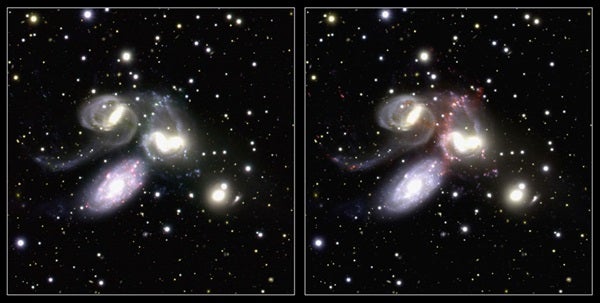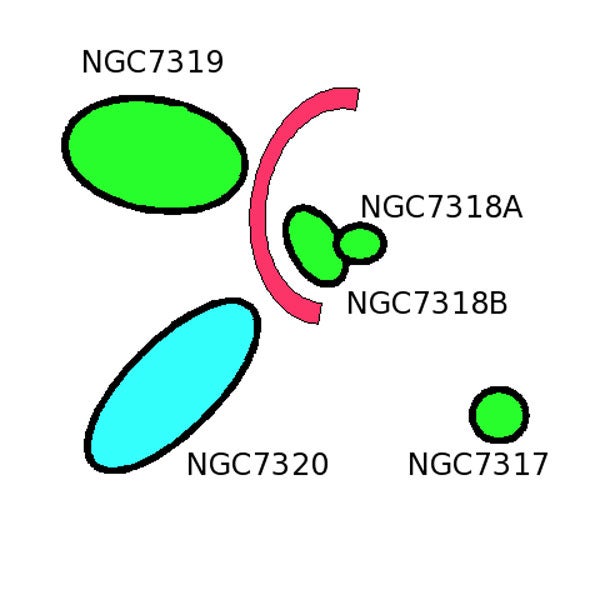The Subaru Telescope has added another dimension of information about one of the most-studied of all compact galaxy groups — Stephan’s Quintet. Located within the borders of the constellation Pegasus, Stephan’s Quintet consists of a visual grouping of five galaxies, four of which form a compact galaxy group; one additional galaxy appears in images of the group but is much closer than the others. Refinements in observations of the quintet are revealing more about its members. A comparison of images (the left and right images in Figure 1) compiled using a suite of specialized filters with Subaru’s Prime Focus Camera (Suprime-Cam) has shown different types of star-formation activity between the closer galaxy NGC 7320 and the more distant galaxies in Stephan’s Quintet. They show the quintet in 3-D.
These new images are the product of Suprime-Cam’s ability to capture images of objects in a wide field of view and to use specialized filters to focus observations according to particular research objectives. To learn about the star-forming regions in Stephan’s Quartet and their structure, observers used an extremely narrow band filter (Hydrogen-alpha), which lets in a specific wavelength of light to indicate distinctive hydrogen emissions during active star formation (an Hα spectral line). They used two Hα filters, each with a different recession velocity, i.e., the speed at which the object is moving away from the observer. They used one Hα filter with a recession velocity of 0, which means that the speed at which the object is moving away from the observer is 0 and that it is not far distant. They used another Hα filter with a greater recession velocity of 4,200 miles (6,700 kilometers) per second, an indicator of distant objects. In addition to the red color of the Hα emission, green and blue filters captured light so that the composite tricolor images aligned with human color perception in red, blue, and green.
Processing of the filtered images resulted in the two different views of Stephan’s Quintet shown in Figure 1. The image on the left shows the galaxies when the observers used the Hα filter with a recession velocity of 0, while the one on the right shows them when the they used the Hα filter with a recession velocity of 4,200 miles (6,700 km) per second. The left image shows Hα emissions that indicate an active star-forming region in the spiral arms of NGC 7320 in the lower left quadrant but not in the other galaxies. The right image contrasts with the left and shows a region of Hα emissions in the upper three galaxies but none from NGC 7320. Two (NGC 7318A and NGC 7318B) of the four galaxies are shedding gas because of a collision while a third (NGC 7319) is crashing in, creating shock waves that trigger vigorous star formation. Figure 2 depicts the relationship of the galaxies. Gas ejected from stars born during such vigorous star formation emits bright light, which the Hα filter reveals. The researchers believe that NGC 7319 and NGC 7318A/B are driving the star-forming regions in the Hα emitting region around NGC 7318A/B.
In addition to star-forming activity, the images indicate the distances of the galaxies. Different recession velocities help observers spot cases where objects located at different distances appear in proximity in the same image. The contrasting images show that NGC 7320 is closer than the other galaxies, which show active star formation at a significantly higher recession velocity than NGC 7320. NGC 7320 is about 50 million light-years away while the other four galaxies are about 300 million light-years away. This explains the intriguing arrangement of the galaxies in Stephan’s Quintet.











